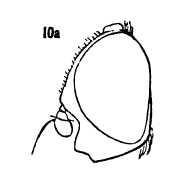Biology:Chrysogaster antitheus
From HandWiki
Short description: Species of fly
| Chrysogaster antitheus | |
|---|---|

| |
| male | |
| Scientific classification | |
| Domain: | Eukaryota |
| Kingdom: | Animalia |
| Phylum: | Arthropoda |
| Class: | Insecta |
| Order: | Diptera |
| Family: | Syrphidae |
| Subfamily: | Eristalinae |
| Tribe: | Brachyopini |
| Subtribe: | Brachyopina |
| Genus: | Chrysogaster |
| Species: | C. antitheus
|
| Binomial name | |
| Chrysogaster antitheus Walker, 1849[1]
| |
| Synonyms | |
Chrysogaster antitheus (Walker, 1849), the Short-haired Wrinkle Fly, is a fairly common species of syrphid fly found in North America. Hoverflies get their names from the ability to remain nearly motionless while in flight. The adults are also known as flower flies for they are commonly found around and on flowers, from which they get both energy-giving nectar and protein-rich pollen. The larvae in this genus are aquatic rat-tailed larvae.[8]
Distribution
Canada , United States .
References
- ↑ Walker, F. (1849). List of the specimens of dipterous insects in the collection of the British Museum. Part III. London: British Museum (Natural History). pp. 485–687.
- ↑ Shannon, R.C. (1916). "Appendix. Systematic and synonymic notes. Pp. 195-203. In Banks, N., Greene, C. T., McAtee, W. L. & Shannon, R. C., District of Columbia Diptera: Syrphidae.". Proceedings of the Biological Society of Washington 29: 173–203. https://www.biodiversitylibrary.org/page/3336684#page/207/mode/1up. Retrieved 14 November 2021.
- ↑ Loew, Hermann (1866). "Diptera Americae septentrionalis indigena". Centuria Septima. Berl. Ent. Z. 10: 1–54.
- ↑ Curran, Charles Howard (1925). "Contribution to a monograph of the American Syrphidae north of Mexico". The Kansas University Science Bulletin. 15: 7–216. https://www.biodiversitylibrary.org/page/4391303#page/15/mode/1up. Retrieved 11 November 2021.
- ↑ Harris, T.W. (1835). Insects. Pp. 553-602. In Hitchcock, E., Report on the geology, mineralogy, botany, and zoology of Massachusetts. 2nd Edition. Amherst: J. S. & C. Adams. pp. [4] + 702 pp., 19 pls, 3 maps.
- ↑ Shannon, Raymond Corbett (1916). "Notes on some genera of Syrphidae with descriptions of new species". Proceedings of the Entomological Society of Washington 18: 101–113. https://www.biodiversitylibrary.org/page/2570915#page/119/mode/1up. Retrieved 21 July 2021.
- ↑ Loew, H. (1870). "Diptera Americae septentrionalis indigena. Centuria nona". Berliner Entomologische Zeitschrift 13(1869): 129–186. https://www.biodiversitylibrary.org/page/8343873#page/147/mode/1up. Retrieved 14 November 2021.
- ↑ Skevington, J.H.; Locke, M.M.; Young, A.D.; Moran, K.; Crins, W.J.; Marshall, S.A (2019). Field Guide to the Flower Flies of Northeastern North America. Princeton Field Guides (First ed.). Princeton, New Jersey: Princeton University Press. pp. 512. ISBN 9780691189406.
Wikidata ☰ Q13494493 entry

